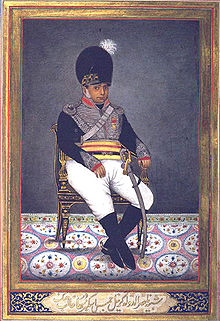James Skinner | |
|---|---|
 James Skinner, from his Tazkirat al-Umara (Account of the Nobles of Delhi and its neighbourhood) | |
| Nickname(s) | Sikandar Sahib |
| Born | 1778 Calcutta, Bengal Presidency |
| Died | 4 December 1841 (aged 62–63) Hansi, Bengal Presidency |
| Service | Maratha Army (1796–1803) Bengal Army (1803–1841) |
| Rank | Colonel |
| Unit | Skinner's Horse |
| Battles / wars | Second Anglo-Maratha War Third Anglo-Maratha War Battle of Malpura |
| Signature |  |
Colonel James Skinner CB (1778 – 4 December 1841)[1] was an Anglo-Indian military adventurer and soldier of the East India Company of British India. Prior to this he also served briefly as a mercenary in the Maratha Army. He became known as Sikandar Sahib later in life and is most known for two cavalry regiments he raised for the British at Hansi in 1803, known as 1st Skinner's Horse and 3rd Skinner's Horse (formerly 2nd Skinner's Horse), which are still units of the Indian Army.[2]
Born to a Scottish father and an Indian mother from the Bhojpur region, he was also fluent in Persian, the court and intellectual language of India in his day.[3] Skinner composed several works in the language, including an extensively illustrated manuscript Kitāb-i Tashrīḥ al-Aqvām (History of the Origin and Distinguishing Marks of the Different Castes of India), now held by the Library of Congress.[4][5]
He is sometimes referred to as the "father of the Indian cavalry".[6] The historian, Mildred Archer, said of Skinner that: "Among military adventurers who have served in India, none was more dashing than the half-Indian leader of the famous Irregular Cavalry Corps known as Skinner's Horse."[7]
- ^ Wheeler 2004.
- ^ "'Dhana/Colonel Skinner's Farm', with Colonel James Skinner CB riding in an open carriage, 1828". National Army Museum. Archived from the original on 18 December 2010.
- ^ Dalrymple, William (2021). The Company Quartet. Bloomsbury. p. 89. ISBN 9781526644909.
- ^ "Manuscript Book on History of Castes in India" Rosenwald Collection, Rare Book and Special Collections Division, by James S. Collins of Pennsylvania
- ^ Cite error: The named reference
glowas invoked but never defined (see the help page). - ^ Pearse, Colonel H.W (1907). "Fathers of the Indian Cavalry". The Cavalry Journal. 2: 287.
- ^ Archer, Mildred (1960). "The Two Worlds of Colonel Skinner, 1778-1841". HistoryToday. 10 (9): 608–615.